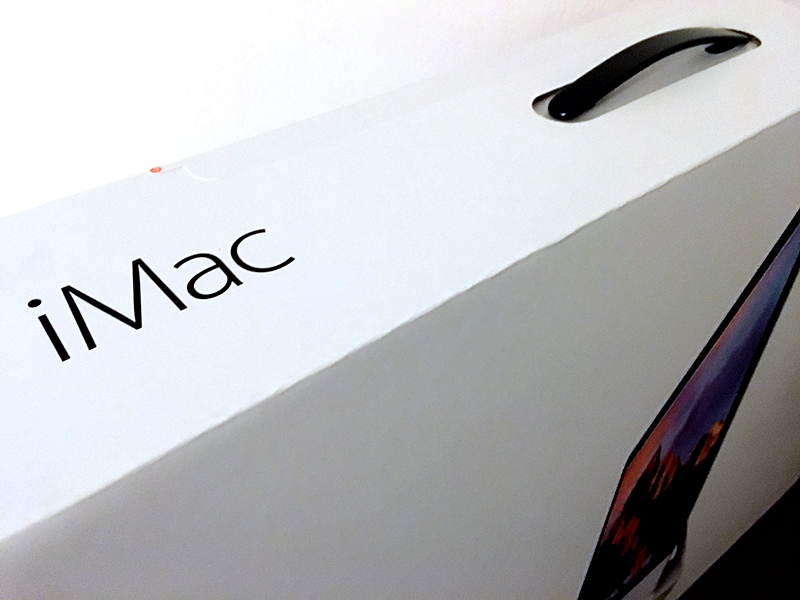This is my new iMac sitting on my desk, waiting to be unboxed. It is one of the first 2017 iMac models to reach consumers. This is the third iMac I bought this month. That is quite a saga.
About a month ago, my 2011 Mac mini’s SSD died. It was the second drive, so I had to pull it out so I could send it back for a warranty replacement, I could just run on the original (slow 5400 RPM) disk drive. But unfortunately, it was worse than I thought. My Mac mini was dead. And I had an online work shift the next day.
So I rushed online (via my iPhone) and bought a refurbished iMac 27″ with 5k Retina Display. I paid for FedEx overnight, and it arrived 10 minutes after my shift started. I plugged it in and got to work immediately. Nice.
But my triumph was short lived. I was extremely hesitant to buy an iMac, the current model was released in 2015 and updates were coming very soon, possibly at Apple’s Worldwide Developer’s Conference (WWDC) on June 5. Everyone put out warnings not to buy an iMac now. But I had no choice, I needed a new computer immediately.

After my work shift, I checked out the machine specs more thoroughly, and was horrified to discover it was an iMac from 2014! I had no idea that 3 year old previous-generation iMacs were available as refurbs direct from Apple. So I got on the phone to Apple and complained this wasn’t the computer I thought I was buying. Apple arranged to swap the computer for a current (2015) model. A few days later, I drove to Des Moines and swapped the computer, and paid about $200 more for a higher spec model. Apple said they have a 14 day exchange, so if a new model was announced at WWDC, it would be too late for the 14 day exchange window.
Of course Apple announced the new iMacs at WWDC. That was Day 17 of my exchange window. Apple generously arranged price protection, refunding me the $200 difference between the 2015 iMac price yesterday, vs the lower price today. And they extended the exchange window. I could replace the iMac a second time, but I’d have to do it in the store. It would take 2 days for the iMacs to reach stores and the first online customers. That day was today. I just returned from the Apple store with my nice new iMac. First I bought an obsolete refurb. Then I swapped it for a current 2015 model. Then that was instantly obsolete and I got the third iMac, and I hope my last for a while.
If you want to know the wrong time to buy a computer, buy one right after I do. I think the worst Mac purchase I ever made was a PowerMac 8100/110. I bought it with my student loan, and it took 6 months to arrive. Someone put an easter egg in the MacOS system software, a picture of Paula Abdul. Apple pulled all the machines out of the pipeline until new MacOS CDROMs were mastered, minus the picture. The 8100/110 was discontinued just 3 months after I received it. I suppose that iMac wasn’t such a bad deal in the end, I set it up as a web server using mkLinux, the prototype for MacOS X. It ran perfectly for quite a few years, and it prepared me for hardcore Unix on Macs. But I’m going to be paying off that computer on my student loan until I’m 90 years old.
*”Frist!” is an old internet meme, it originated on Slashdot.com. Comments were listed in chronological order, people often raced to make the first comment so they could write “First Post!” Then one day someone mistyped it “Frist!” and it stuck. People would post “Frist” to poke fun at the firstposters. This meme goes back to the late 1990s, which makes it the Internet equivalent of classical literature like Shakespeare.
 You can see a little blue semicircle under one of the icons at top, that indicates virtual disk activity. This VM is only supposed to use 2 of my 4 cores, but it still bogs down my entire Mac. Actions that are supposed to take one click can take 30 seconds of watching the spinning beach ball. I haven’t even launched this VM for 6 months, and Windows still manages to make me miserable.
You can see a little blue semicircle under one of the icons at top, that indicates virtual disk activity. This VM is only supposed to use 2 of my 4 cores, but it still bogs down my entire Mac. Actions that are supposed to take one click can take 30 seconds of watching the spinning beach ball. I haven’t even launched this VM for 6 months, and Windows still manages to make me miserable.





